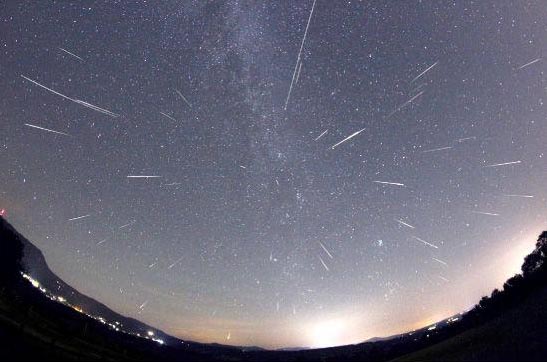Sky Report August 10 – August 16

Photo: Meteors radiate from the northeast but appear all over the sky.
THE event this week is the annual Perseid Meteor Shower which peaks on the evening of Tuesday the 11th.
Meteors, also called “shooting stars” are the flash of light you see when a piece of dust from outer space falls through our atmosphere. They fall so fast – in this case at 37 miles per second or 130,000 miles per hour – that friction with the air burns them up in seconds at a height of 50 miles or more. Faint meteors are caused by dust-size particles while brilliant meteors come from something the size of a marble. Every night random meteors fall at the rate of approximately six per hour.
A meteor shower happens when the earth moves through a swarm of particles shed by a comet long ago. The tail of Comet NEOWISE we saw recently is made of dust shed by the evaporating dirty-ice nucleus, and those particles drift away, following in the comet’s orbit. When we pass near that orbit, we plow through a swarm of dust and see a meteor shower.
These meteors come from dust shed by Comet Swift-Tuttle. We pass through the swarm at the same point in our orbit each year, in mid-August. The shower lasts all week but peaks on the night of the 11th.
Most meteors are faint, so for best effect it’s essential to have a dark sky. Dress warmly, lie comfortably, and look up. These meteors appear to radiate from the direction of the constellation Perseus (and hence their name, Perseid) which is very low in the northeast after dark. As the hours pass and Perseus rises higher you’ll see more meteors, and the best time to look is the morning hours of the 12th when you might see up to one meteor per minute. Most people look on the night of Tuesday the 11th when meteors fall at the rate of one every few minutes.
While watching for meteors notice the four bright planets out tonight. Jupiter and Saturn are in the southeast as the sky grows dark; Jupiter is the brighter of the two. Mars rises in the east around midnight. Venus rises at 4 AM and is a third of the way up the eastern sky at sunrise. The crescent moon is near Venus on the morning of the 15th in a nice pairing and photo op.
The Sky Report is presented as a public service by the Stellar Vista Observatory, a nonprofit organization based in Kanab, Utah, which provides opportunities for people to observe, appreciate, and comprehend our starry night sky. Additional information is at www.stellarvistaobservatory.org. Send questions and comments to John@StargazingAdventures.org.






Comments are closed.